Roman Mosaic (late 2nd – early 3rd Century AD); depicting Leda and the Swan, once central panel (emblema) of a Mosaic Floor. It was discovered in the vicinity of the Sanctuary of Aphrodite at Palaipafos in Cyprus.In mythology, Zeus (Roman Jupiter) seduces the Spartan Queen Leda in the guise of a Swan.
Paolo Caliari, known as Paolo Veronese (1528 – 19 April 1588) was an Italian Renaissance painter based in Venice, most famous for large history paintings of both religious and mythological subjects. With Titian, who was at least a generation older, and Tintoretto, ten years older, he was one of the “great trio that dominated Venetian painting of the cinquecento” or 16th-century late Renaissance. Veronese is known as a supreme colorist, and after an early period with Mannerist influence turned to a more naturalist style influenced by Titian.
44 Works, Leda and the Swan, art from a Greek myth, with footnotes. A subject that has been a favourite with artists throughout the centuries.

After Michelangelo (1475–1564)Leda and the Swan, c. 1530copy of a lost painting by MichelangeloOil on canvasNational Gallery
The design appears to derive from a classical motif known from copies after sarcophagus reliefs and gems. The pose is similar to that of Michelangelo’s ‘Night’ (Medici Chapel, Florence).
The work is probably an old copy after a painting of this subject by Michelangelo which he made in 1530, in tempera, for the Duke of Ferrara, but which was sent instead to the King of France. More

Leda and the Swan is a story and subject in art from Greek mythology in which the god Zeus, or Jupiter, in the Roman version, in the form of a swan, seduces or rapes Leda, the daughter of the King of Aetolia, and married to the Spartan King Tyndareus. According to later Greek mythology, Leda bore Helen and Polydeuces, children of Zeus, while at the same time bearing Castor and Clytemnestra, children of her husband Tyndareus, the King of Sparta.
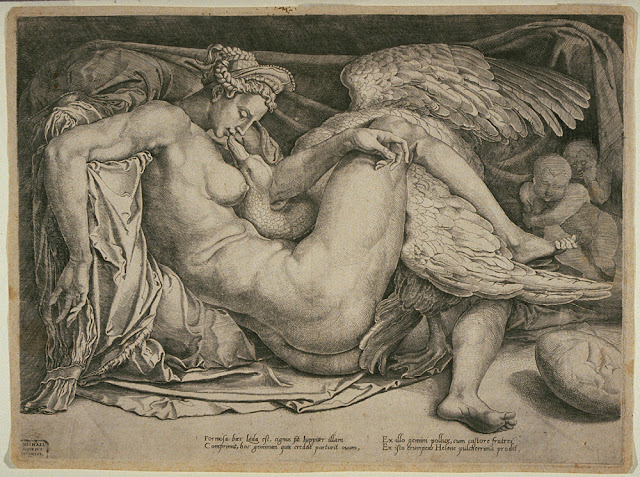
Cornelis Bos, Flemish, ca. 1510–before 1566 after Michelangelo Buonarroti, 1475–1564Leda and the Swan, after 1537Engraving
In his lifelong quest to acquire all things Italian, François I always sought to attract the greatest lights of Italian painting to his court. While he succeeded in convincing the aged Leonardo to enter his service in 1516, and, in so doing, obtained the Mona Lisa for France, the transalpine journey was a difficult and dangerous one, and neither Andrea del Sarto nor the notoriously overcommitted Michelangelo could accept François’s invitation.
However, a rare panel painting of Leda and the Swan by Michelangelo did make its way to France in the possession of Michelangelo’s pupil, Antonio Mini, who seems to have sold it to François. It entered the royal collection at Fontainebleau in the early 1530s, and François’s court painter, Rosso Fiorentino, even painted a copy of it. The painting has since been lost. This print, engraved and published by the Flemish artist Cornelis Bos, is the only record of Michelangelo’s completed painting. Bos, whose first prints date to 1537, must have seen the work at Fontainebleau during a journey to France sometime after this date. More

Ridolfo GhirlandaioLeda and the Swan, c. (1460) Ridolfo di Domenico Bigordi, better known as Ridolfo Ghirlandaio (14 February 1483 – 6 June 1561) was an Italian Renaissance painter active mainly in Florence. He was the son of Domenico Ghirlandaio. He was born in Florence. Since he was eleven years old when his father died, Ridolfo was brought up by his uncle Davide Ghirlandaio, also a painter. Vasari states that he received further training under Fra Bartolomeo. His works painted between 1504 and 1508 show a marked influence from Fra Bartolomeo and Raphael, with whom he was friends. Raphael asked Ridolfo to join him in Rome in 1508, but the Florentine painter stayed. In Florence, he became one of the most prominent painters of altarpieces, frescoes, and portraits, many of which survive. He was also the head of a thriving workshop whose pupils included Michele Tosini (also known as Michele di Ridolfo), Domenico Puligo, Bartolomeo Ghetti, Antonio del Ceraiolo, Toto del Nunziata, Mariano Graziadei da Pescia, Carlo Portelli and others. Ridolfo was prominent in the execution of works for various public occasions, such as the wedding of Giuliano de’ Medici, and the entry of Leo X into Florence in 1515. By 1527 he had already accumulated a handsome property, more than sufficient in maintaining the affluence of his large family of fifteen children. His sons traded in France and in Ferrara, and he himself took a part in commercial affairs. The family villa at Colle Ramole, near Florence, still has a chapel with frescoes by Ridolfo depicting the Virgin and Child with saints adored by members of the Ghirlandaio family. In addition to painting, Ridolfo also experimented with mosaics, but it seems that only one such work, the Annunciation over the door of the Santissima Annunziata, survives today. In his old age Ridolfo was greatly disabled by gout. More on Ridolfo Ghirlandaio
Peter Paul Rubens (1577–1640)” Leda and the Swan ” before 1600Oil on panel64.5 × 80.5 cm (25.4 × 31.7 in)Louvre-Lens
Peter Paul Rubens was a well known artist during the Baroque era. He completed hundreds of works in various mediums—many were famous at the time and still are today. But there are also many works of art that people don’t know much about. One of these works is his painting Leda and the Swan. He painted two versions of this subject. The first was completed in 1601 and the second was completed in 1602. More
In the W. B. Yeats version, it is subtly suggested that Clytemnestra, although being the daughter of Tyndareus, has somehow been traumatized by what the swan has done to her mother. According to many versions of the story, Zeus took the form of a swan and raped or seduced Leda on the same night she slept with her husband King Tyndareus.
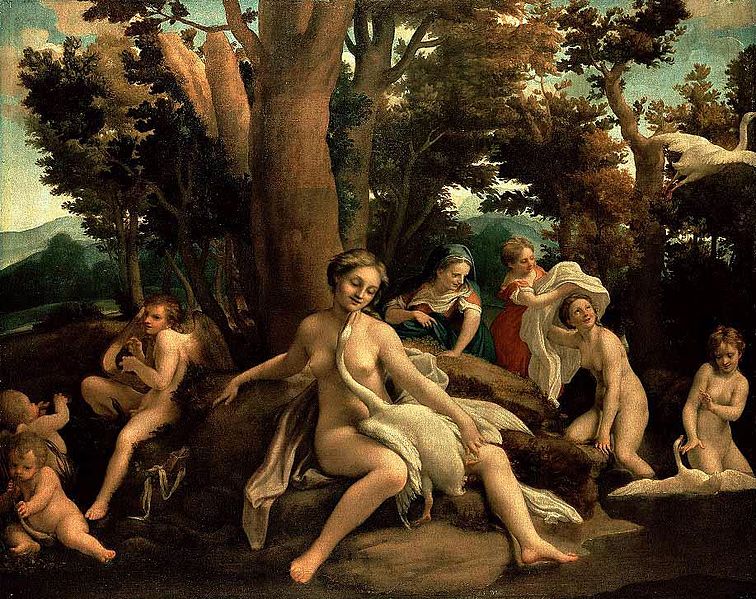
Antonio da Correggio (1490–1534)Leda with the Swan, c. between 1531 and 1532Oil on canvasHeight: 152 cm (59.8 in). Width: 191 cm (75.2 in).Gemäldegalerie, Berlin
Correggio painted the commonest of the various versions of the ancient myth: Jupiter approached Leda on the banks of the river Eurota in the guise of a swan and seduced her. Leda and the swan can be seen on the bank in front of a clump of trees, on the left are two amoretti with wind instruments and a boyish Cupid with his lyre. lt is uncertain whether the figures on the right are Leda’s companions or a simultaneous presentation of other scenes from the story.
Correggio was the leading painter of the Parma school of the Italian Renaissance. Between 1503 and 1505 he was apprenticed to Francesco Bianchi Ferrara of Modena where he became familiar with the classicism of artists like Lorenzo Costa and Francesco Francia, who deeply influenced his first works. His first major commission was the decoration of the ceiling of the private dining salon of the mother-superior in the Convent of St. Paul in Parma in 1519. The dome of the Cathedral of Parma was also adorned by him. Apart from his religious artworks, he created a very prominent set of mythological paintings based on Ovid’s Metamorphoses.
Correggio prefigured the Rococo art of the 18th century in his use of dynamic composition, illusionistic perspective and dramatic foreshortening. ‘Leda with the Swan’ (1531-32) is one of his best known works among his famous frescoes in Parma. More

Bartolomeo AmmannatiLeda and the Swan (c. 1536)Marble, height 50 cmMuseo Nazionale del Bargello This sculpture of Leda is essentially a study piece, a small-scale work that translates a now lost Michelangelo design into three-dimensions. It shows Ammanati attempting to master the kinds of figural inventions that defined Michelangelo’s artistry, but the choice to carry out the composition in stone also reflects an awareness that the sculptor did not work in absolute liberty, that he always had to deal with the given block.
Ammanati sent the statue to Francesco Maria della Rovere, the Duke of Urbino. More
 Luca Cambiaso (1527-1575)Leda and the swan, between 1560 and 1570Oil on canvas151x95 cmI have no further description, at this time Leda and the swan is an extraordinary style painting belonging to a period of Luca Cambiaso not always supported by the same creative impulse. The work in fact, referring to the years around 1570, is definitely one of the greatest achievements in the purity of lines and elegant stylized forms. The imposing figure of the swan, which houses within the great wings of the diaphanous body Leda, manages to preserve the majesty of the father of the gods, Zeus, hiding under his remains, according to the myth that describes one of the most fascinating amorous tricks. In 1999 Maria Cali in the book “The second manner of profane paintings by Luca Cambiaso” published “Leda and the Swan” as an authentic work of the painter Ligurian emphasizing in a special way as the theme dedicated to the loves of Jupiter in the Italian painting of the early sixteenth century was particularly widespread episode of fertilization of the fascinating queen of Spartan by Jupiter by turning into a swan… More
Luca Cambiaso (1527-1575)Leda and the swan, between 1560 and 1570Oil on canvas151x95 cmI have no further description, at this time Leda and the swan is an extraordinary style painting belonging to a period of Luca Cambiaso not always supported by the same creative impulse. The work in fact, referring to the years around 1570, is definitely one of the greatest achievements in the purity of lines and elegant stylized forms. The imposing figure of the swan, which houses within the great wings of the diaphanous body Leda, manages to preserve the majesty of the father of the gods, Zeus, hiding under his remains, according to the myth that describes one of the most fascinating amorous tricks. In 1999 Maria Cali in the book “The second manner of profane paintings by Luca Cambiaso” published “Leda and the Swan” as an authentic work of the painter Ligurian emphasizing in a special way as the theme dedicated to the loves of Jupiter in the Italian painting of the early sixteenth century was particularly widespread episode of fertilization of the fascinating queen of Spartan by Jupiter by turning into a swan… More
Luca Cambiasi (18 November 1527 – 6 September 1585) was an Italian painter and draftsman, familiarly known as Lucchetto da Genova. Cambiasi was precocious, and at the age of fifteen he painted, along with his father, some subjects from Ovid’s Metamorphoses on the facade of a house in Genoa. In 1544, at the age of seventeen, he was involved in the decoration of the Palazzo Doria, now the Prefettura. He aided in the vault decoration of the church of San Matteo. His Resurrection and Transfiguration altarpieces for San Bartolomeo degli Armeni date from c. 1560. In 1563, he painted a Resurrection for San Giovanni Battista in Montalto Ligure. This was followed by frescoes for the Villa Imperiale at Genoa-Turalba (also called the Palazzo Imperiali Terralba) with a Rape of the Sabines (c. 1565) and the Palazzo Meridiana (formerly Grimaldi; also in 1565). In the Capella Lercari of the Duomo di San Lorenzo, Cambiasi frescoed a Presentation and Marriage of the Virgin in 1569, remainder of chapel by Castello.
The 1911 Britannica states that Cambiasi by his thirties began to decline in skill, though not at once in reputation, owing to the vexations brought upon him by a passion which he conceived for his sister-in-law. His wife having died, and the sister-in-law had taken charge of his house and children, he failed to procure a papal dispensation for marrying her.
In 1583 he accepted an invitation from Philip II to complete for the Escorial a series of frescoes begun by Castello; and the 1911 Encyclopædia states the principal reason for traveling to Spain was that he hoped royal influence would gain favor with the Vatican for his marriage plans, but this failed. In the Escorial he executed a Paradise on the vaulting of the church, with a multitude of figures. For this picture he received 2,000 ducats, probably the largest sum that had, up to that time, ever been given for a single work. His paintings in Spain, hew to strict religious thematic. More
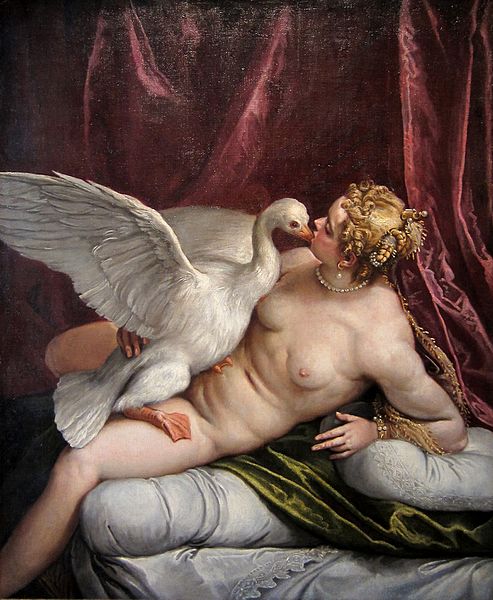
Paolo Veronese (1528–1588)Leda and the Swan, c. circa 1585Oil on canvasheight: 121 cm (47.6 in); width: 100 cm (39.3 in)Musée Fesc Paolo Caliari, known as Paolo Veronese (1528 – 19 April 1588) was an Italian Renaissance painter based in Venice, most famous for large history paintings of both religious and mythological subjects. With Titian, who was at least a generation older, and Tintoretto, ten years older, he was one of the “great trio that dominated Venetian painting of the cinquecento” or 16th-century late Renaissance. Veronese is known as a supreme colorist, and after an early period with Mannerist influence turned to a more naturalist style influenced by Titian. More

Leda & the SwanGreco-Roman mosaic
C3rd A.DMuseum of Cyprus, Nicosia
Leda and the Swan Mural in Herculaneum (Italy) – c 150 b.C
In some versions, she laid two eggs from which the children hatched. In other versions, Helen is a daughter of Nemesis, the goddess who personified the disaster that awaited those suffering from the pride of Hubris.
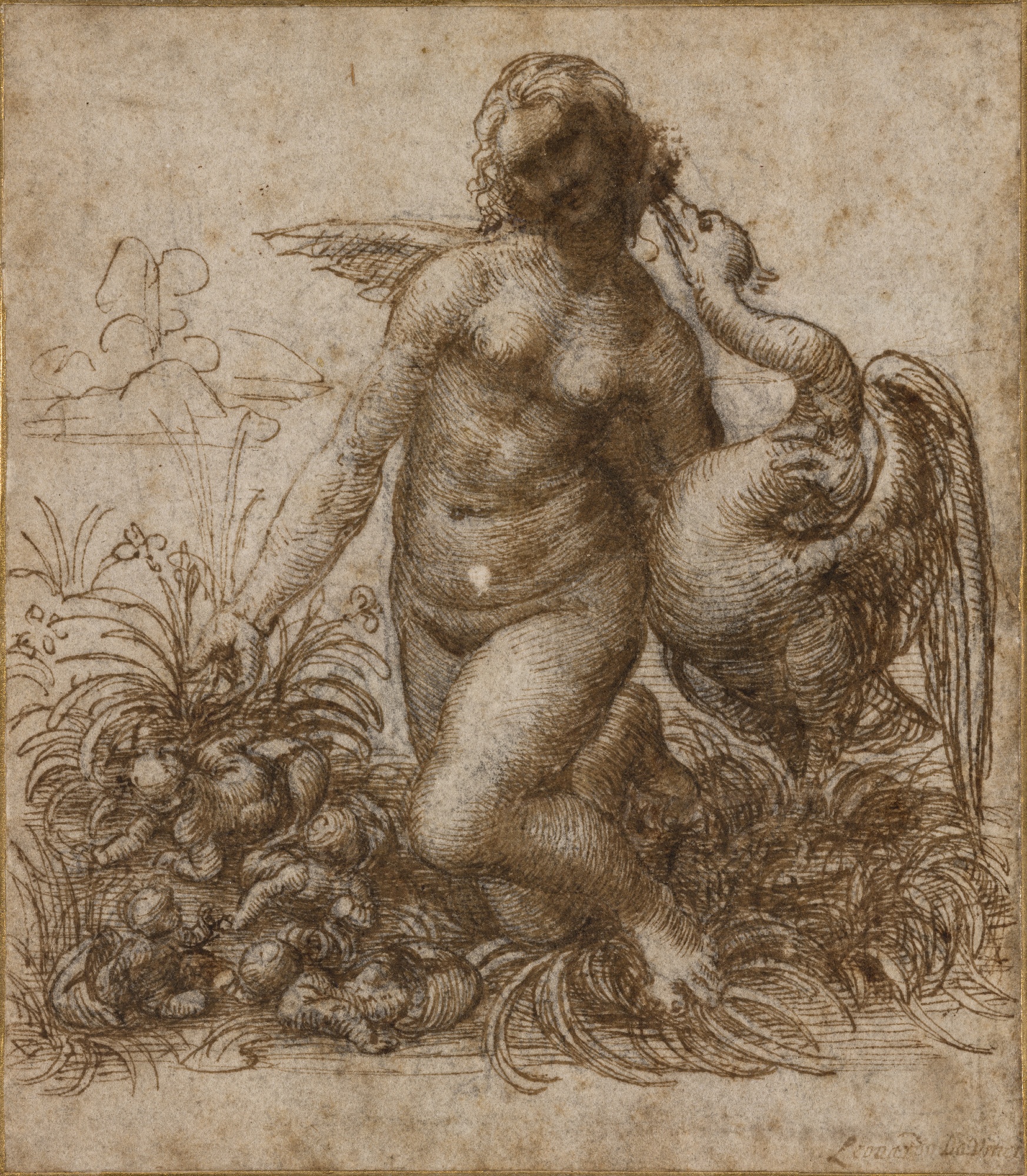
Leonardo da Vinci.Study for the Kneeling Leda (c. 1505 – 1507)Drawing on paper A standing figure of Leda almost entirely naked, with the swan at her and two eggs, from whose broken shells come forth four babies, This work, although somewhat dry in style, is exquisitely finished, especially in the woman’s breast; and for the rest of the landscape and the plant life are rendered with the greatest diligence. Unfortunately the picture is in a bad state because it is done on three long panels which have split apart and broken off a certain amount of paint. More

Francesco Melzi after a lost painting by Leonardo da VinciLeda and the Swan, c. 1508-1515Oil on canvasheight: 131 cm (51.5 in); width: 78 cm (30.7 in)Galleria degli Uffizi, Florence. Francesco Melzi (ca. 1491 – 1568/1570) was an Italian painter. He was the son of a Milanese noble family. Melzi joined the household of Leonardo da Vinci in 1506. He accompanied Leonardo on trips to Rome in 1513 and to France in 1517. As a painter, Melzi worked closely with and for Leonardo. Some works which, during the nineteenth century, were attributed to Leonardo are today ascribed to Melzi.[citation needed]
Upon Leonardo’s death, Melzi inherited the artistic and scientific works, manuscripts, and collections of Leonardo, and would henceforth faithfully administer the estate. Melzi wrote to Leonardo’s brothers to notify them of his death, and in this letter he described Leonardo’s love for his pupils as “sviscerato e ardentissimo amore” a selfless and incandescent love.
Returning to Italy, Melzi married, and fathered a son, Orazio. When Orazio died on his estate in Vaprio d’Adda, his heirs sold the collection of Leonardo’s works. More
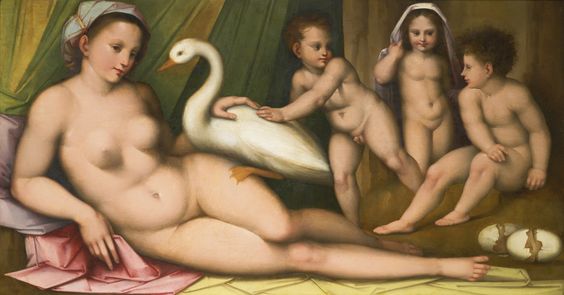
Andrea Piccinelli, called Andrea BrescianinoSIENA CIRCA 1487 – AFTER 1525LEDA AND THE SWANOil on panel 68.5 x 129.8 cm.; 27 x 51 1/8 in.Private collection Likely painted in Siena in the 1520s this unusual panel was probably intended as the headboard to a bed in a marital chamber. It compares closely with other such works by the artist and his greatest Sienese influence Domenico Beccafumi; all of these, like this, depict a famous woman as their principle subject. More Andrea del Brescianino or Dei Piccinelli was an Italian painter of the Renaissance period, active mainly in Siena. Together with his brother Raffaello they were known as the Brescianini of Siena. He was the son of a dancing-master at Siena, where he flourished from 1507 to 1525. He was the pupil of a Sienese painter, named Giovanni Battista Giusi, and they together painted an altar-piece, representing the Virgin and Child, with Saints, which is in the Siena Academy. In 1524, he painted the Baptism of Christ for the baptistery of the cathedral of the same city. In 1525 the brothers went to Florence, and in the same year Andrea, and probably Raffaello also, was registered in the Painters’ Guild. A Holy Family by Andrea, who was the better artist of the two, is in the Uffizi Gallery at Florence, and another Holy Family, ascribed to him, is in the Berlin Gallery. The beautiful altar-piece, a Holy Family displayed at the church of Torre di Bibiano, long attributed to Baldassare Peruzzi, has been attributed to Andrea. The brothers appear to have worked under the influence of Fra Bartolommeo. More
 Vincent Sellaer Leda and the Swan, c. 1538Oil on panel109.5 × 88 cm (43.1 × 34.6 in)Musée des Beaux-Arts, Valenciennes Vincent Sellaer (1490 – 1564), was a Flemish Renaissance painter of mythological and religious subjects. Very few of the biographical details of this artist are known with any level of certainty. Although there is still no unanimous consensus, it is accepted by most scholars that Vincent Sellaer should be identified with the artist to whom the early 17th century biographer Karel van Mander referred as Vincent Geldersman. Van Mander described Sellaer as a good painter of allegories, such as Leda with two eggs, Susanna and the elders, and Cleopatra with the asp. Van Mander mentioned him in his Life of Frans Minnebroer as one of the notable painters of Mechelen. While many known versions of a Leda and the Swan have been attributed to Sellaer, none has survived that depicts a Leda with eggs. More
Vincent Sellaer Leda and the Swan, c. 1538Oil on panel109.5 × 88 cm (43.1 × 34.6 in)Musée des Beaux-Arts, Valenciennes Vincent Sellaer (1490 – 1564), was a Flemish Renaissance painter of mythological and religious subjects. Very few of the biographical details of this artist are known with any level of certainty. Although there is still no unanimous consensus, it is accepted by most scholars that Vincent Sellaer should be identified with the artist to whom the early 17th century biographer Karel van Mander referred as Vincent Geldersman. Van Mander described Sellaer as a good painter of allegories, such as Leda with two eggs, Susanna and the elders, and Cleopatra with the asp. Van Mander mentioned him in his Life of Frans Minnebroer as one of the notable painters of Mechelen. While many known versions of a Leda and the Swan have been attributed to Sellaer, none has survived that depicts a Leda with eggs. More  Pontormo (1494–1557)Leda and the Swan. between 1512 and 1513Oil on panelHeight: 55 cm (21.7 in). Width: 40 cm (15.7 in).Uffizi Gallery Jacopo Carucci (May 24, 1494 – January 2, 1557), usually known as Jacopo da Pontormo, was an Italian Mannerist painter and portraitist from the Florentine School. His work represents a profound stylistic shift from the calm perspectival regularity that characterized the art of the Florentine Renaissance. He is famous for his use of twining poses, coupled with ambiguous perspective; his figures often seem to float in an uncertain environment, unhampered by the forces of gravity. More One of Pontormo’s earliest works, Leda and the Swan, influenced by da Vinci’s own depiction of Leda, hangs in the Uffizi. Though, the piece is still sometimes argued to be a work of Sarto or possibly Perin del Vaga (1501 – 1547). More
Pontormo (1494–1557)Leda and the Swan. between 1512 and 1513Oil on panelHeight: 55 cm (21.7 in). Width: 40 cm (15.7 in).Uffizi Gallery Jacopo Carucci (May 24, 1494 – January 2, 1557), usually known as Jacopo da Pontormo, was an Italian Mannerist painter and portraitist from the Florentine School. His work represents a profound stylistic shift from the calm perspectival regularity that characterized the art of the Florentine Renaissance. He is famous for his use of twining poses, coupled with ambiguous perspective; his figures often seem to float in an uncertain environment, unhampered by the forces of gravity. More One of Pontormo’s earliest works, Leda and the Swan, influenced by da Vinci’s own depiction of Leda, hangs in the Uffizi. Though, the piece is still sometimes argued to be a work of Sarto or possibly Perin del Vaga (1501 – 1547). More 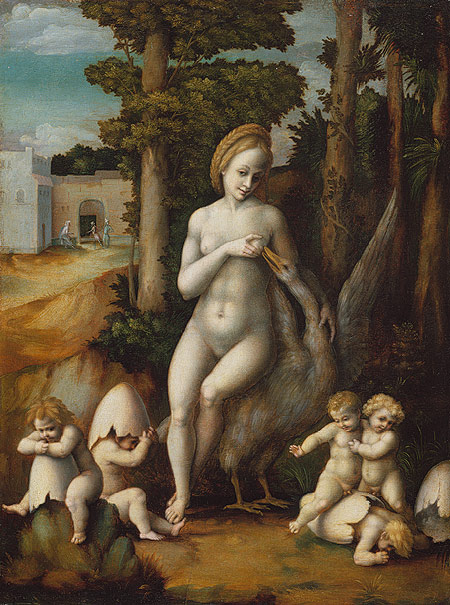 Bacchiacca (1494–1557)Leda and the Swan, 16th centuryOil on panelMetropolitan Museum of Art Francesco d’Ubertino Verdi, called Bachiacca (1494–1557) was an Italian painter of the Renaissance whose work is characteristic of the Florentine Mannerist style. He was born and baptized in Florence on March 1, 1494 and died there on October 5, 1557. He apprenticed in Perugino’s Florentine studio, and by 1515 began to collaborate with Andrea del Sarto, Jacopo Pontormo and Francesco Granacci on painted furnishings for the bedroom of Pierfrancesco Borgherini and Margherita Acciauoli. In 1523, he again participated with Andrea del Sarto, Franciabigio and Pontormo in the decoration of the antechamber of Giovanni Benintendi. While he established a reputation as a painter of predellas and small cabinet pictures, he eventually expanded his output to include large altarpieces, such as the Beheading of St. John the Baptist, now in Berlin.
Bacchiacca (1494–1557)Leda and the Swan, 16th centuryOil on panelMetropolitan Museum of Art Francesco d’Ubertino Verdi, called Bachiacca (1494–1557) was an Italian painter of the Renaissance whose work is characteristic of the Florentine Mannerist style. He was born and baptized in Florence on March 1, 1494 and died there on October 5, 1557. He apprenticed in Perugino’s Florentine studio, and by 1515 began to collaborate with Andrea del Sarto, Jacopo Pontormo and Francesco Granacci on painted furnishings for the bedroom of Pierfrancesco Borgherini and Margherita Acciauoli. In 1523, he again participated with Andrea del Sarto, Franciabigio and Pontormo in the decoration of the antechamber of Giovanni Benintendi. While he established a reputation as a painter of predellas and small cabinet pictures, he eventually expanded his output to include large altarpieces, such as the Beheading of St. John the Baptist, now in Berlin.
In 1540, Bachiacca became an artist at the court of Duke Cosimo I de’ Medici and Duchess Eleanor of Toledo. In this capacity, Bachiacca’s first major commission was to paint the walls and ceiling of the duke’s private study with plants, animals and a landscape. Bachiacca also made cartoons for two series of tapestries, the Grotesque Spalliere (1545–49) and the Months (1550–1553), which were woven by the newly founded Medici tapestry works. All of these works either contain carefully observed illustrations of nature or display the artist’s trademark method and style, in which Bachiacca combines figures, exotic costumes and other motifs acquired from Italian artists and German and Netherlandish prints into entirely new compositions. These cosmopolitan assemblages exhibited the most praiseworthy elements of both northern and southern European Renaissance art, which appealed to their courtly clientele. More
 Antoine Coypel (1661–1722)Leda and The SwanOil on canvasNational Trust for Scotland, Brodie Castle
Antoine Coypel (1661–1722)Leda and The SwanOil on canvasNational Trust for Scotland, Brodie Castle
